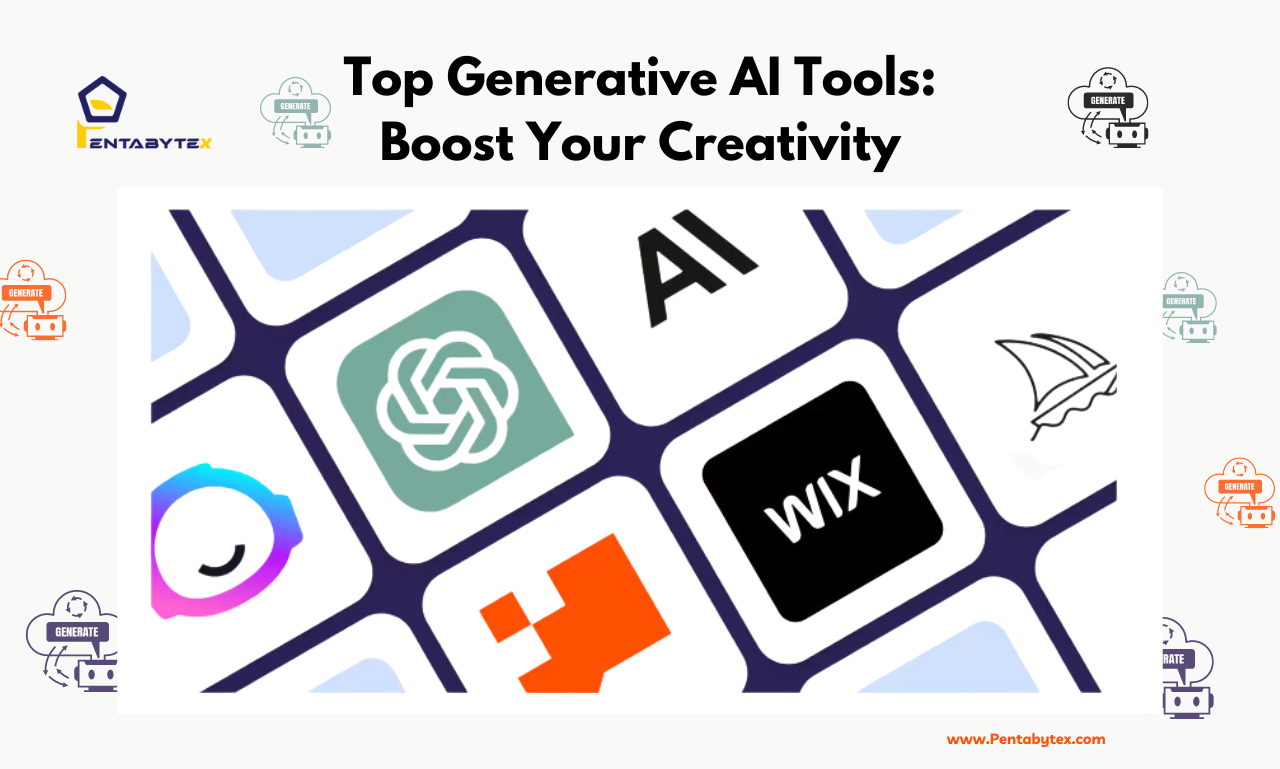Rapidly gaining popularity, generative AI tools provide innovative solutions for things like content creation, design, and more. It doesn’t matter if you are a marketer or even a developer; these tools will make your workflow faster as well as boost your imagination.
In this article, we shall look at some of the amazing generative AI tools present nowadays.
What is Generative AI?
Generative AI is a branch of artificial intelligence that aims to generate new content by utilizing already learned information. Unlike classical models, which solely predict or categorize different aspects, this kind produces completely fresh documents, pictures, or codes that are innovative.
This ability enables it to find applications in various sectors, such as advertising technology as well as movie production and programming.
How do Generative AI Tools Work?
Generative AI tools apply deep learning techniques, particularly neural networks that require large datasets for training. These models can learn about the patterns and structures of content, and it is often possible for them to generate new content that is similar to the original content in terms of its style, tonality, or even shape.
Training: Training involves big datasets such as text, images, or any other types of content.
Fine-tuning: It refers to making them apt for specific tasks such as writing articles or creating pictures.
Generation: As it is called, comes once the model has already been trained and it starts associating what it has learned from the previous examples while processing user input.
This form of creation includes text and pictures going up through music and even computer programming codes as possible end products.
For more on how AI is enhancing various fields, explore AI Applications in Various Fields.
Top Generative AI Tools
Here is an overview of key features, pros and cons, working, and pricing of the top 10 generative AI tools:
1. ChatGPT
One of the most popular tools that apply AI for content creation is ChatGPT, developed by OpenAI. As a natural language processing tool that is programmed to write human-like text, it is very useful when writing articles and responding to customers.
Key Features:
- Natural Language Understanding
- Conversational Context
- Open Domain Conversations
- Language Fluency
- Creative Writing
- Language Translation
- Text Completion and Suggestion
- Personalized interactions
Pros:
- There are more natural interactions with accurate responses offered.
- It has free access for everyone.
Cons:
- It can be subject to errors and random misuse.
- In addition, it is also limited in knowledge of events after September 2021.
Pricing:
- A free tool is available for basic use.
- ChatGPT Plus starts at $20 monthly for enhanced features and fast response times.
2. GPT-4
The latest model by OpenAI is called GPT-4, and it is even better than GPT-3 in terms of understanding and language generation capability. As for the ideal use of the model, it is suitable for users who require high-level text generation ranging from content writing to research activities.
Key Features
- GPT-4 has 100 trillion parameters.
- Improved creativity
- Enhanced Steerability
- Image Input Capability
- Multilingual Capability
- Outperformance on Multiple Benchmarks
- Human-Level Performance on Various Benchmarks
Pros:
- Produces very precise and contextually appropriate materials.
- They are flexible when it comes to the input and output data type; whether text or image.
Cons:
- It uses computational power a lot due to the nature of some of the problems or tasks it solves.
- There may be situations in which premium accessibility would set the cost beyond the reach of some users.
Pricing:
API Access: Fees depend on the usage of the app and range between $0.03 per 1K tokens and above.
3. AlphaCode
DeepMind’s AlphaCode is an AI tool that uses generative technology to assist in programming. This is accomplished through the generation of code snippets, optimization of algorithms, and provision of solutions for programming challenges.
Key Features:
- Code Generation
- Algorithm Optimization
- Multilingual Support
- Problem-solving capabilities
Pros:
- Provides fast and accurate coding suggestions, hence saving time.
- Facilitates efficient resolution of intricate programming problems.
Cons:
- Concentrated primarily on coding with limited uses outside the software development field.
- It is still a research tool, thereby having restricted availability to normal users.
Pricing:
Research Tool: Not yet out for public usage, with price information to be determined.
4. GitHub Copilot
GitHub Copilot, which is driven by OpenAI’s Codex, is an AI tool that helps programmers use the coding editor it is directly incorporated into by providing them with code snippets in addition to completing functional codes. It means to enhance output when it comes to handling ordinary tasks on the computer.
Key Features:
- In-editor suggestions
- Supports Multiple Languages
- Contextual Understanding
- Learn from Code
Pros:
- Saves time by automating repetitive tasks.
- Perfect alignment with well-known code editors, including Visual Studio Code.
Cons:
- Inaccurate or wrong problems could lead to human scrutiny.
- Need of internet connection for real-time suggestions.
Pricing:
Subscription-Based: $10/month for individual developers, with corporate plans existing.
5. Claude
Claude, developed by Anthropic, is a conversational AI tool designed for ethical and safe AI interactions. It’s particularly focused on ensuring that AI responses are safe, non-harmful, and aligned with human values.
Key Features:
- Ethical AI Interactions
- Contextual Responses
- User-Centric Design
- Scalable
Pros:
- Ensures safe and ethical AI interactions.
- Versatile for various conversational AI applications.
Cons:
- Still in the early stages, with ongoing research and development.
- Limited public access at this stage.
Pricing:
- Beta Access: Currently available through a waitlist; pricing details to be announced.
6. Cohere Generate
Cohere Generate is an AI tool that can generate text for various applications, such as creative writing and business. It is distinguished by its emphasis on customization and scalability, making it very popular among enterprises.
Key Features:
- Training of Custom Models
- Integration with APIs
- Fine Generation of Text
- Scalability
Pros:
- Models tailored to suit specific industries.
- The solution can expand to suit enterprises.
Cons:
- Requires technical expertise in its setup and customization.
- Pricing may exclude small businesses or individual users.
Pricing:
- Custom Pricing: Based on usage and specific needs, with enterprise solutions available.
7. Jasper AI
Jasper AI, previously referred to as Jarvis is an acclaimed artificial intelligence writing assistant that is adept at drafting marketing advertisements, composing blog posts, or even generating social media updates. It particularly proves valuable for marketers and creators of content who require top-notch writing materials instantly.
Key Features:
- Content Generation
- Tone Customization
- SEO Integration
- Template Library
Pros:
- It’s easy to use, with a primary focus on creating marketing material.
- It generates SEO-compliant material.
Cons:
- It is restricted to text generation only; no images or other multimedia forms are supported by this toolset.
- Higher pricing levels may be costly for small businesses.
Pricing:
- Starter Plan: $29/month for 20k words.
- Boss Mode: $59/month for 50k words plus additional features.
8. DALL-E 2
Just like DALL-E, OpenAI has yet another generative AI tool known as DALL-E 2, which is used for creating images from textual descriptions. Designers, marketers, and artists can use this powerful tool to come up with unique visuals.
Key Features:
- Text-to-Image Generation
- Artistic styles
- High-Resolution Output
- Creative Customization
Pros:
- Ideal for producing personalized images according to certain specifications.
- Flexible when it comes to different forms and modes of expressive artistry.
Cons:
- Producing pictures can be an extravagant process demanding lots of resources.
- Limited access because one’s only options are either signing up for an API or waiting on beta invites.
Pricing:
- API access is subject to usage; specific details are available upon request.
9. Runway ML
Runway ML is an innovative AI tool and creative for artists and creators that can generate videos, images, and texts. It is widely known for its minimalism and the inclusion of a large number of AI models.
Key Features:
- Video and Image Generation
- Real-Time Collaboration
- Extensive Model Library
- No-Code Interface
Pros:
- User-friendly, with no coding required.
- Ideal for multimedia content creation.
Cons:
- Some advanced features may require technical knowledge.
- Limited to creative applications, with less focus on text-based content.
Pricing:
- Basic Plan: Free with limited features.
- Pro Plan: $35/month for full access to models and features.
10. Bard
When it comes to generating high-quality content and assisting with different writing tasks, Bard (developed by Google) is one of the leading generative AI tools that exist. It allows users to tap into Google’s vast resources of information, hence why it is such an important tool in the arsenal of every marketer, researcher, or content creator.
Key Features:
- Creation of Content
- Comprehension of Context
- Flexible Styles of Writing
- Access to Current Information
Pros:
- Ensures correct and relevant content generation through Google’s wide database.
- Can adjust to various writing requirements and approaches.
Cons:
- Access might be limited based on availability or its involvement with Google’s services.
- The best results need careful formulation of the prompts.
Pricing:
- Free Access: Basic features at no cost.
- Premium Subscription: Provides advanced functions as well as larger usage ranges; pricing details are obtainable upon request.
Choosing the Right Generative AI Tool: Tips and Tricks
However, knowing what solution to implement may not be as easy to figure out, especially when there are so many generative AI tools available in the market today.
Define Your Needs: Running the tool in some specific mode, for example, text generation, image generation, or code generation, and using the tool specifically for that.
For example, AI in Mobile App Development highlights how generative AI can improve the creation of applications.
Ease of Use: The factor of constructiveness is considered on whether it is usable or not. Some of the applications require a certain level of skill base, while on the other hand, some can be operated with little or no proficiency at all.
Cost: Understand how much it would cost you to use the tool or whether it is going to fit your budget and requirements. Some of the tools are free for use by any individual, while others are only available for paid subscribers.
Features: First, let’s find out which parts of it each of these tools provide. Does your targeted audience need to see the type of content that you want to post? It is also important to know how suitable the workflow is in the context of your current approaches.
Explore AI Reinforcement Learning for insights on advanced features.
Considering these factors, one can identify the specific generative AI tool to use to meet a particular need and improve efficiency.
Conclusion
The recently developed generative AI tools are even changing how content is being generated and consumed in the digital society. They include a text generator and an image generator, and these tools improve probabilities that, if done physically, would require a lot of time.
That is why it shall become possible to determine the essential parameters and benefits of the most effective tools out there and then select the suitable one. Today, it is possible to think ahead and understand how generative AI tools will be beneficial for your work.
Additionally, consider how AI technologies like AI and ML in Mobile Apps can further optimize your processes.







